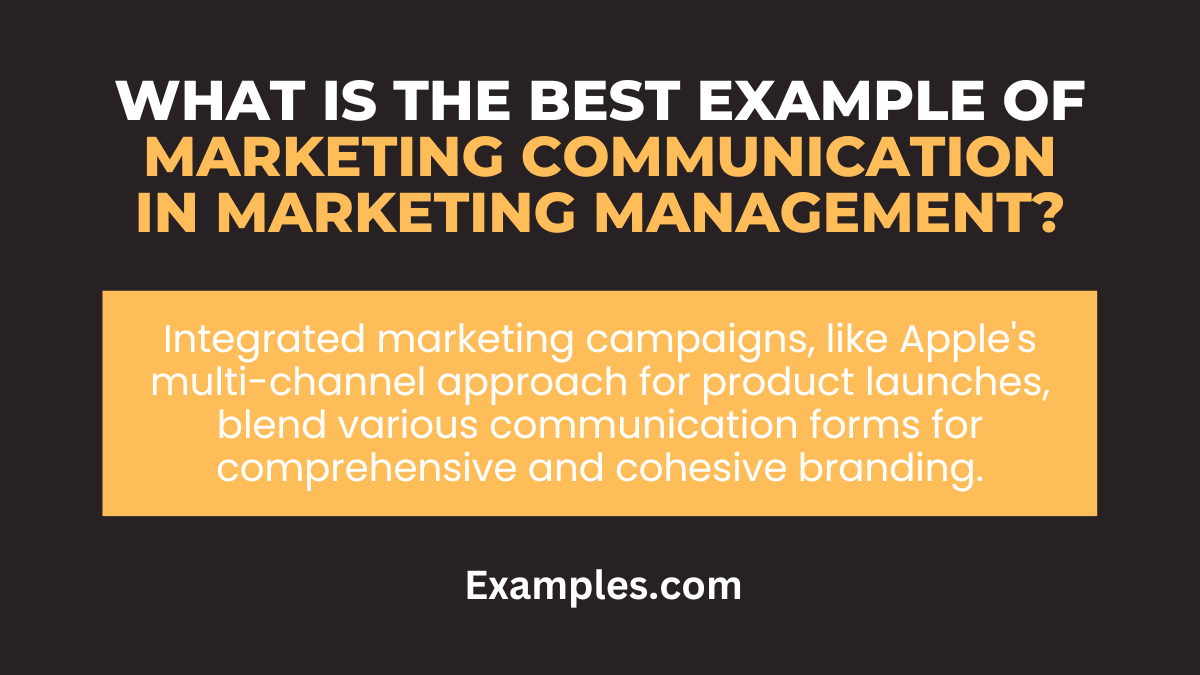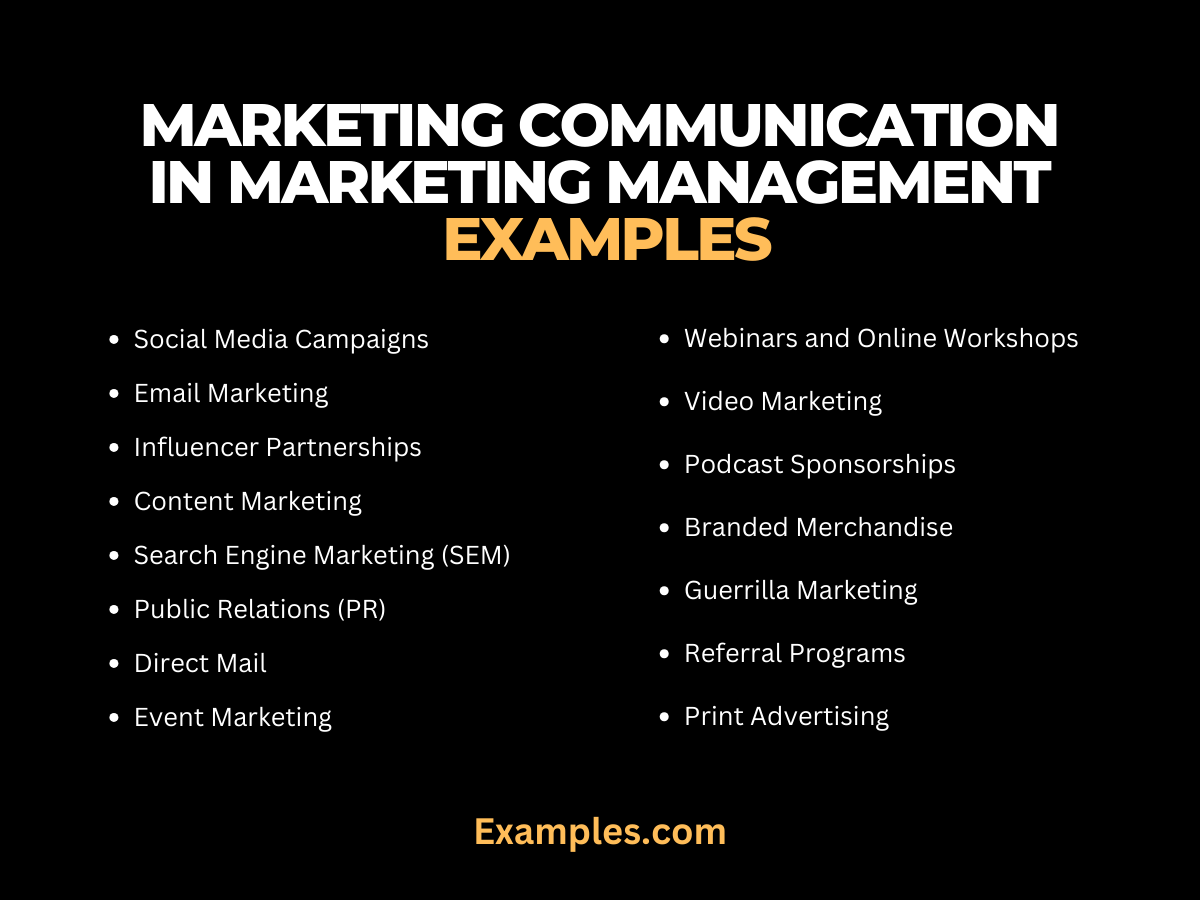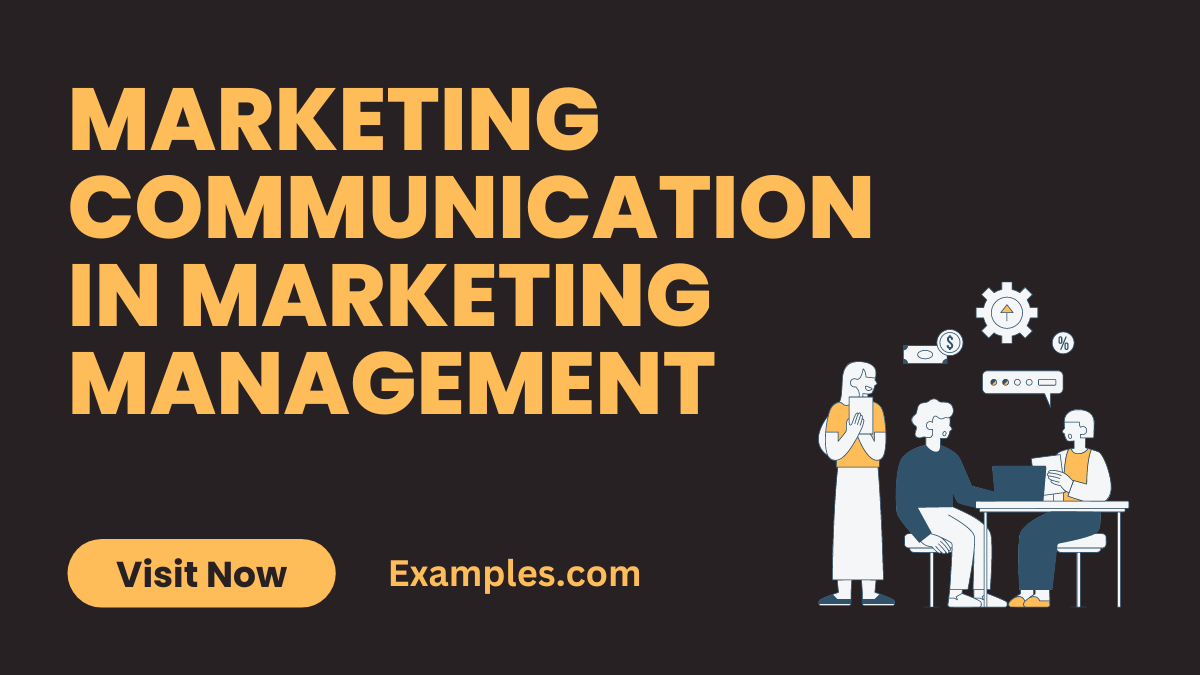Marketing Communication in Marketing Management
Embark on a journey through the dynamic world of Marketing Communication in Marketing Management with this comprehensive guide. Here, we delve into the intricate blend of creativity and strategy that makes effective marketing communication indispensable. This guide includes a rich array of examples, showcasing how internal communication and external marketing strategies work hand-in-hand to build brand identity, engage customers, and drive business growth. Whether you’re a seasoned marketer or new to the field, these examples and insights will equip you with the tools to navigate the ever-evolving landscape of marketing communication.
What is Marketing Communication in Marketing Management?

Marketing Communication in marketing management refers to the various methods and strategies used by companies to convey their marketing messages to their target audience. It encompasses a range of activities including advertising, public relations, direct marketing, and more. This form of communication is essential for promoting products, building brand awareness, and establishing market presence. Effective marketing communication is a blend of art and science, requiring creativity, strategic planning, and an in-depth understanding of consumer behavior.
What is the Best Example of Marketing Communication in Marketing Management?

A prime example of marketing communication in marketing management can be seen in integrated marketing campaigns. These campaigns combine various forms of communication such as social media, traditional advertising, and public relations to create a cohesive and comprehensive marketing strategy. For instance, Apple’s product launches are exemplary, where they effectively use a mix of keynote presentations (events), social media buzz, influencer partnerships, and traditional advertising to create anticipation and excitement around new products. This multi-channel approach ensures a wide reach and reinforces the brand message across different platforms and audiences.
15 Marketing Communication in Marketing Management Examples

Dive into the realm of Marketing Communication in Marketing Management with these 15 unique examples, showcasing the versatility and impact of effective marketing strategies. From traditional advertising to digital campaigns, these examples highlight how innovative communication methods can significantly boost brand recognition, customer engagement, and sales. Each example offers a glimpse into the creative and strategic thinking that shapes successful marketing efforts, providing valuable insights for businesses looking to enhance their marketing communication tactics.
- Social Media Campaigns: Brands using social media platforms to engage with audiences through interactive content.
- Example: “Our latest social media campaign increased engagement by featuring user-generated content, connecting our brand with our audience’s everyday experiences.”
- Email Marketing: Personalized email campaigns targeting specific customer segments with tailored messages.
- Example: “Our email marketing strategy focuses on personalized offers based on the customer’s previous purchases, enhancing relevance and response rates.”
- Influencer Partnerships: Collaborating with influencers to reach wider audiences in an authentic way.
- Example: “Partnering with lifestyle influencers, we expanded our brand’s reach to a new, engaged audience.”
- Content Marketing: Providing valuable and relevant content to attract and retain a clearly defined audience.
- Example: “Our blog posts and how-to guides position us as thought leaders in our industry, fostering trust and loyalty.”
- Search Engine Marketing (SEM): Using paid advertising on search engines to increase website visibility.
- Example: “Our SEM campaigns focus on high-converting keywords, significantly boosting our online visibility and sales.”
- Public Relations (PR): Managing the spread of information between an organization and the public.
- Example: “Our PR strategy includes media releases and community events to enhance our brand reputation.”
- Direct Mail: Sending promotional materials directly to potential customers through physical mail.
- Example: “Our targeted direct mail campaigns deliver personalized offers, resulting in a high response rate.”
- Event Marketing: Hosting or participating in events to promote a brand, product, or service.
- Example: “Our product launch events create excitement and media attention, directly engaging with our target audience.”
- Webinars and Online Workshops: Conducting online educational sessions to engage and inform customers.
- Example: “Our webinars provide valuable insights, establishing a connection with our audience and promoting our expertise.”
- Video Marketing: Using video content to engage customers, often on platforms like YouTube or social media.
- Example: “Our how-to video series on YouTube has not only increased brand visibility but also customer engagement.”
- Podcast Sponsorships: Sponsoring podcasts that align with the brand’s audience for targeted exposure.
- Example: “Sponsoring a popular health podcast allowed us to reach health-conscious consumers effectively.”
- Branded Merchandise: Distributing products with the company’s logo to enhance brand recognition.
- Example: “Our branded merchandise serves as a constant reminder of our brand to our customers.”
- Guerrilla Marketing: Unconventional marketing tactics that create a memorable experience.
- Example: “Our guerrilla marketing stunt in the city center created buzz and viral social media content.”
- Referral Programs: Encouraging current customers to refer friends and family to the brand.
- Example: “Our referral program rewards both the referrer and the new customer, enhancing loyalty and reach.”
- Print Advertising: Using traditional print media like newspapers and magazines for advertising.
- Example: “Our print ads in industry-specific magazines target a niche, professional audience effectively.”
Marketing Communication Process in Marketing Management
The Marketing Communication Process in marketing management is a multifaceted approach that involves a series of steps to ensure effective delivery of marketing messages. It begins with identifying the target audience and ends with evaluating the effectiveness of the communication.
- Identification of the Target Audience: Understanding who the audience is crucial. It involves analyzing demographic, psychographic, and behavioral patterns to tailor messages effectively.
- Setting Communication Objectives: Clear objectives, such as brand awareness, lead generation, or customer retention, guide the strategy and help measure success.
- Crafting the Message: The message should align with the brand’s values and appeal to the identified audience. It should be clear, concise, and compelling.
- Selecting the Right Channels: Choosing appropriate channels, whether digital or traditional, is key to reaching the audience effectively. This might include social media, email, print media, or television.
- Feedback and Evaluation: Gathering feedback through surveys, social listening, or analytics helps in evaluating the effectiveness of the communication and making necessary adjustments.
Why is Marketing Communication Important in Marketing Management?
Marketing Communication plays a pivotal role in marketing management for several reasons:
- Building Brand Awareness: It helps in creating visibility for the brand, making potential customers aware of its existence and offerings.
- Customer Engagement: Effective communication fosters customer engagement, encouraging interaction and building relationships.
- Differentiation in the Market: It allows a brand to differentiate itself from competitors, highlighting unique selling points.
- Driving Sales: Strategic marketing communication can directly influence consumer purchasing decisions, thereby driving sales.
- Building Long-term Customer Relationships: Consistent and honest communication helps in building trust and loyalty among customers, which is crucial for long-term success.
What are the Key Components of a Marketing Communication Strategy in Marketing Management?
A robust Marketing Communication Strategy in marketing management comprises several key components:
- Target Audience: Understanding the audience is the foundation of any strategy. It involves identifying who the customers are and what they need.
- Clear Objectives: Setting specific, measurable, achievable, relevant, and time-bound (SMART) objectives is critical for strategy effectiveness.
- Content Strategy: Developing a content strategy that resonates with the audience and effectively communicates the brand’s message.
- Channel Strategy: Selecting the right mix of channels, including digital communication, social media, email, and traditional media, to reach the audience.
- Measurement and Analysis: Implementing tools and techniques for measuring the effectiveness of the communication strategy and making data-driven adjustments.
In conclusion, this comprehensive guide illuminates the vital role of Marketing Communication in Marketing Management. Through a blend of strategic planning, creative execution, and continual analysis, businesses can effectively communicate their message, engage with their audience, and achieve marketing objectives. These insights and examples offer a roadmap for crafting impactful marketing communication strategies that resonate in today’s competitive marketplace.



